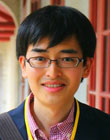Top>People>Bridge over the sea: A modern Japanese envoy to China
 Index
Index
Bridge over the sea: A modern Japanese envoy to China
Nobuyuki Tsuji
Chairperson of Management Committee, NPO Tokyo Academy for Liberal Arts
Doctoral Program in Chuo University Graduate School of Policy Studies
It all started suddenly and unexpectedly with an email that I received from Hao Yanshu, a lecturer at Chuo University and Professor of Meiji University School of Business Administration. Hao encouraged me to apply for the Japan-China Youth Friendship Exchange Trip to China for which the Chinese Embassy was recruiting participants, and she would give me a recommendation. I responded immediately to this fortuitous opportunity and ultimately ended up traveling to Xiamen on December 23, 2015.
This exchange trip to China is sponsored by the Society of Chinese Professors in Japan and the Japan China Science, Technology and Culture Center, and is backed by the Chinese Embassy.
Participants in the exchange trip were 141 students and working adults who had received recommendations from the two sponsors listed above. They were grouped into three courses (A, B and C) as they traveled in China (see separate table).
I was able to participate in Course C, which toured Xiamen, Fuzhou, the Wuyi Mountains and Shanghai. I was also appointed as leader and placed in charge of coordinating the 48 participants in my course.
Spicy welcome dinner
Waiting for us outside of Xiamen Gaoqi International Airport was a misty city in the middle of the rainy season. The temperature was 23 degrees Celsius with 97% humidity, which was much different from Tokyo in late December.
We headed for the restaurant where a dinner party was scheduled. Xiamen is known as the home of Fujian cuisine, which has a light flavor and is popular among Japanese people. However, the food served to us was extremely spicy Szechuan cuisine.
Many people in my group were profusely sweating and their nose was running as they struggled to eat the spicy food. With my love for red peppers and Sichuan peppers, the dinner was a wonderful greeting for me.
The next day, we headed to Xiamen University for exchange activities. Upon arriving, Assistant Professor Chen Fang greeted us in English. As leader of Course C, I gave a speech in Chinese.
Xiamen University is one of China’s largest comprehensive universities and has been designated as a National Key University by the Chinese government. Currently, approximately 40,000 undergraduate and graduate students are enrolled in 66 colleges and 26 schools. Chinese students from the Department of Japanese Language and Literature guided us as we strolled through the vast campus, which features classic architecture with Chinese glazed roof tiles.
Beautiful (but obscured) scenery
After leaving the university, my group boarded a ferry and traveled to Gulangyu Island. The island features Western architecture preserved from the period of Concessions in China. Vibrant bougainvillea were in full bloom across the island. The island is known as “Piano Island” because many residents own pianos.
We climbed Sunlight Rock, the highest point on Gulangyu Island. If the weather had been sunny, we would have seen the red buildings of the Gulangyu Island Historical District directly below us, as well as the skyscrapers of Xiamen city in the distance.
Unfortunately, the day of my visit was drizzly and misty. However, there are times when you can enjoy certain landscapes even when the view is obscured. Consider this quote from Shige Kanai, who has traveled in 126 countries: “I can’t believe that you are disappointed just because it’s raining. There are 365 days in one year, and the temperature and humidity is different every single day. Everything is different—the shape of the clouds and the way in which the rain falls. Life is a waste if you can’t enjoy such things.”
Industrial city
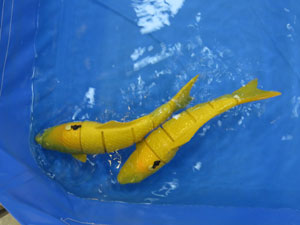
Artificial carp robot (Fuzhou University)
It was a three-hour bus ride from Xiamen to Fuzhou. First, we visited Sono Gensya (創之源社) , a company which handles wooden products. The company’s showroom was filled with tables which cost hundreds of thousands of yen. The surfaces of the tables had been varnished and shined brilliantly. The adjacent room was packed with Buddhist images and statues created by utilizing the inherent shape of wood.
Next, we headed to the College of Mechanical Engineering and Automation at Fuzhou University. Our main host was Professor Chen Shuo, who had taught at Nagasaki University. After exchanging pleasant greetings in Japanese, we toured facilities including an artificial carp robot which is being developed on campus.
That evening, we divided into smaller groups for free time in Sanfang Qixiang, an entertainment district lined with traditional buildings from Ming Dynasty and Qing Dynasty. The neighborhood features a wide range of shops offering products from traditional antiques to pop-culture Western clothes.
My group went to a steakhouse located at the end of the main street and dined on beef flavored with Chinese star anise. I was impressed by the culture which fused the cuisine of different regions into a single Chinese food.
Sacred Wuyi Mountains
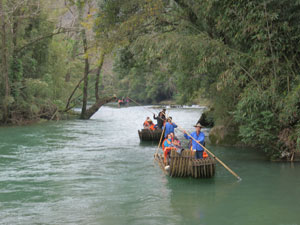
Traveling down the Jiuquxi River on a bamboo raft (Wuyi Mountains)
We then took a four-hour bus ride from Fuzhou to reach the World Heritage Site of the Wuyi Mountains. The area is famous as the holy land of high-quality tea. Participants in Course C were guided to stores giving tea demonstrations at the tea-manufacturing plants.
First, we tried Oolong tea. The moment the tea passed my lips, a refreshing flavor spread through my mouth. The clear variations in taste expanded like a hanging scroll, eventually giving way to an after-taste known as Wuyi Mountains Rock Tea. The next tea we tried was lapsang souchong, which tasted quite different from normal black tea. It was like a mixture of half Oolong tea and half black tea.
Tables selling tea were covered with huge piles of boxes filled with Oolong tea and lapsang souchong. Next to these piles, there was a small amount of black tea in cans labeled Jin Jun Mei. Prior to coming to China, I had heard how wonderful Jin Jun Mei tea was from Professor Peng Hao (Chuo University Faculty of Policy Studies), who conducts research on tea culture. I immediately purchased a can.
Upon returning to Japan, I tried the Jin Jun Mei tea and was thrilled by the deep, mellow flavor. The tea has a mystic flavor which seems like it will lengthen the lifespan of those who drink it.
On our first day at the Wuyi Mountains, we traveled down the Jiuquxi River on a raft made of bamboo. That night, we watched an outdoor theater performance of the Impression Da Hong Pao Show, which was produced by the Chinese film director Zhang Yimou.
The next day, we climbed Tian You Feng. This peak is famous for providing panoramic views of the Wuyi Mountains. After climbing up steep stairs for nearly one hour, we reached the summit and witnessed a world like an ink painting. A Taoist temple is located on the summit, and red strips of cloth on which people had written their wishes fluttered from the trees.
In the afternoon, we visited and prayed at the Eiraku Zen Temple, the only Zen temple in the Wuyi Mountains. In this way, we also experienced the Wuyi Mountains as a sacred religious region.
Strange delicacies
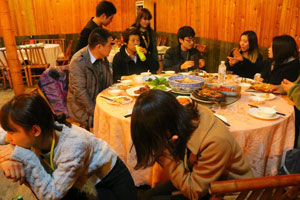
Please take a look at the picture on the right.
The two young women in the front are turning their faces away and crying. The two young women seated at the right are expressing signs of shock.
There are four men and women on the left calmly watching on. Among them two have moved behind me and slightly smiling. What is going on? The cause of this scene is that the person sitting in the middle (me!), had just eaten a turtle.
Our final dinner in the Wuyi Mountains was filled with strange delicacies. Rabbits and frogs had been cut into small pieces and were arranged on the round table. The big pot of soup contained a whole turtle and a duck.
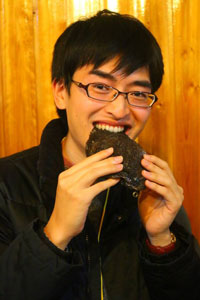
I eat a turtle (Wuyi Mountains)
Many young women were terrified by this sight and a commotion arose at each table. In particular, at my table, two young women immediately turned their backs on the table and started crying. I was more surprised by their reaction than I was by the turtle and duck.
Afterwards, I was even more surprised to hear that the turtle in the soup was a Chinese soft-shelled turtle. I’m sure that it is rare for a whole turtle to be placed in turtle soup.
The flavor of the soup was refined and light, but with strong richness created by concentrated extract from the duck. The soft-shelled turtle had a glutinous texture around the edges of the shell. The hind legs were the most delicious part. I felt bad for the young women who couldn’t enjoy gazing upon such an unparalleled feast.
Mystical atmosphere of Shanghai
After finishing our dinner of strange delicacies, my group traveled to Shanghai via a newly-opened expressway.
The next day, we visited Shanghai Jiao Tong University, where we were greeted by Professor Ji Weidong, a Doctor of Law. Professor Weidong has worked tirelessly for many years in order to foster friendship between Japan and China.
Similar to Xiamen University, Shanghai Jiao Tong University is designated as a National Key University. On the campus, we toured a R&D Center for aircraft and marine vessels parts. We also visited Tsung-Dao Lee Library, which is named after the first Chinese scientist to win the Nobel Prize in Physics.
Afterwards, we ate dim sum for lunch in downtown Shanghai and then visited Yuyuan Garden. We also enjoyed the mystical atmosphere at the Yuyuan Tourist Mart located adjacent to the garden.
That evening, we crossed the Bund and Nanjing Road on our way to the Xinjiang Uygur restaurant where we would eat dinner. At the restaurant, the Courses A, B, and C reconvened and reported on our activities during the past week. After enjoying lamb dishes while watching dances performed by Hui people, we watched a show by the Shanghai Acrobatic Troupe. The following morning, we began our journey back to Japan.
A feeling of hope for the future
About one month after we returned to Japan, a reporting session by the members of the exchange trip was held at the Chinese Embassy in Motoazabu, Tokyo. As leader of Course C, I reported on the positive results of the exchange trip.
The first result was that many members unflinchingly used the Chinese language to engage in communication with locals. The second result was that members who have just begun learning about China were able to learn much from expert members.
The third result was that the exchange trip was a precious opportunity for deep exchange between students and working adults, making it possible to form relationships which will be continued in the future. The fourth result was that the exchange trip inspired many more members to consider studying abroad or working in China, as well as to make personal visits to China in order to serve as a bridge for friendship between the two countries at feasible levels.
Minister Liu Shaobin gave the following message: “You are all part of a modern Japanese envoy to China. I hope that you will use your own words to share with other people in Japan what you learned in China on the exchange trip.”
Minister-Counselor Xue Jian also gave us a message of encouragement: “Your report gave hope for the future of friendship between Japan and China.”
When the second Japan-China Youth Friendship Exchange Trip to China is held, I hope that there will be even more participation from students, graduate students, and graduates of Chuo University.
Overall schedule for the 2015 Japan-China Youth Friendship Exchange Trip to China
| Date | Course A (Shanghai - Nanjing - Huai’an - Suzhou) |
Course B (Shanghai - Hangzhou - Shaoxing - Ningbo) |
Course C (Xiamen - Fuzhou - Wuyi Mountains - Shanghai) |
|---|---|---|---|
| Dec. 23 (Wed.) |
Arrive at Shanghai Hongqiao International Airport | Arrive at Xiamen Gaoqi International Airport | |
| Tour of commercial facilities in downtown Shanghai | Tour of commercial facilities in downtown Xiamen | ||
| Dec. 24 (Thur.) |
Visit Shanghai Jiao Tong University for exchange activities | Visit Xiamen University for exchange activities History & Cultural Tour at Nanputuo Temple | |
| Travel from Shanghai to Nanjing | Cultural Tour at Shanghai Yuyuan Garden Travel from Shanghai to Hangzhou | ||
| Dec. 25 (Fri.) |
Historical studies and University exchange Nanjing, Southeast University, Sun Yat-sen Mausoleum, and Xuanwu Lake | University exchange and World Heritage Site Tour at Hangzhou Dianzi University and West Lake Cultural Landscape of Hangzhou | Travel from Xiamen to Fuzhou University exchange at Fuzhou University for exchange activities History and Cultural Tour to the historical and cultural area of Sanfang Qixiang |
| Dec. 26 (Sat.) |
Travel from Nanjing to Huai'an History studies and Tour to the Zhou Enlai Memorial Museum, Ming Ancestors’ Mausoleum and former residence of Wu Chengen Travel to Suzhou |
Travel from Hangzhou to Shaoxing History and Culture Tour to the famous Shaoxing Castle View the Lantingji Xu written by Wang Xizhi Tour the former residence of Lu Xun |
Travel from the city to Wuyi Mountains World Heritage Site Wuyi Mountains National Scenic Area: Jiuquxi River and Wuyi palace Culture studies: View the Impression of Wuyi Mountains from series of Impressions |
| Dec. 27 (Sun.) |
World Heritage Site and Industry Tour to the Classical Gardens of Suzhou and the Suzhou Silk Museum | Travel from Shaoxing to Ningbo Industrial Visit and tour the Ningbo National Hi-tech Industrial Development Zone Cultural Visit to the Museum of the Tianyi Pavilion |
World Heritage Site Tour to the Wuyi Mountains National Scenic Area: Tian You Feng Travel from Wuyi Mountains to Shanghai via expressway |
| Dec. 28 (Mon.) |
Travel from Suzhou to Shanghai Tour Shanghai |
Cultural Tour to Eastern Jin Temple, Aikuo-ji Temple and Tiantong Temple Travel from Ningbo to Shanghai |
University exchange to Shanghai Jiao Tong University Cultural Tour to the Shanghai Yuyuan Garden |
| Dec. 29 (Tues.) |
Return to Japan from Shanghai Hongqiao International Airport | ||
- Nobuyuki Tsuji
Chairperson of Management Committee, NPO Tokyo Academy for Liberal Arts
Doctoral Program in Chuo University Graduate School of Policy Studies -
Nobuyuki Tsuji was born in Yokohama in 1989. Currently, he is enrolled in the Doctoral Program in the Chuo University Graduate School of Policy Studies. He serves as Chairperson of Management Committee at NPO Tokyo Academy for Liberal Arts and Incentive Researcher at the Hosei University Institute for Okinawan Studies.
While conducting repeated fieldwork on isolated islands based on religious studies and ethnology, he conducts research on a variety of borders, including those between Japan and China, and those between this world and the afterlife.
His main written works include The Boundary through Drawing Images of the Other World -A Case Study of Kikaijima. -
Web Magazine EFG

NPO Tokyo Academy for Liberal Arts
- Research Activities as a Member of Research Fellowship for Young Scientists (DC1), Japan Society for the Promotion of Science (JSPS) Shuma Tsurumi
- Important Factors for Innovation in Payment Services Nobuhiko Sugiura
- Beyond the Concepts of Fellow Citizens and Foreigners— To Achieve SDGs Goal 10 “Reduce Inequality Within and Among Countries” Rika Lee
- Diary of Struggles in Cambodia Fumie Fukuoka
- How Can We Measure Learning Ability?
—Analysis of a Competency Self-Assessment Questionnaire— Yu Saito / Yoko Neha - The Making of the Movie Kirakira Megane








